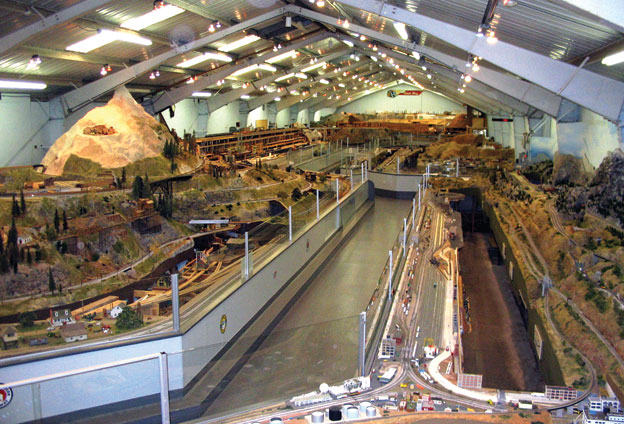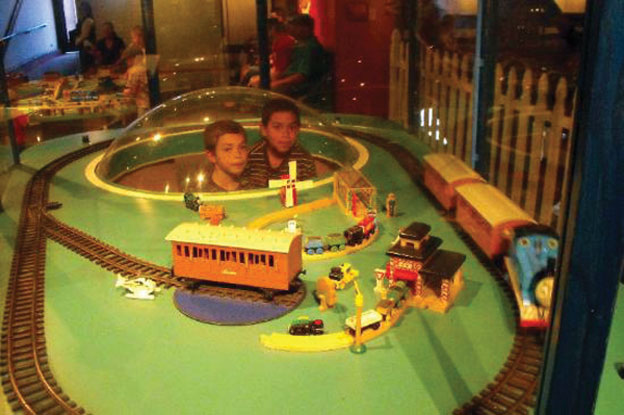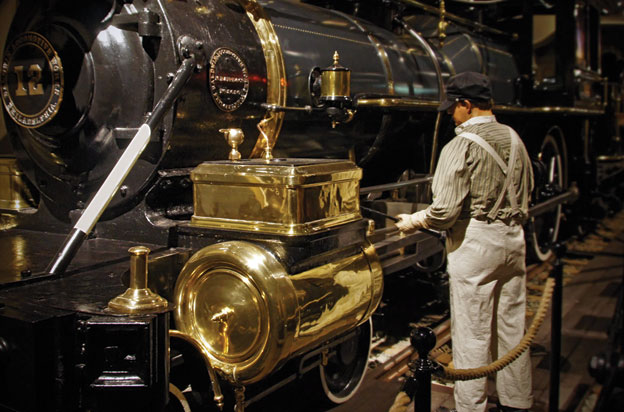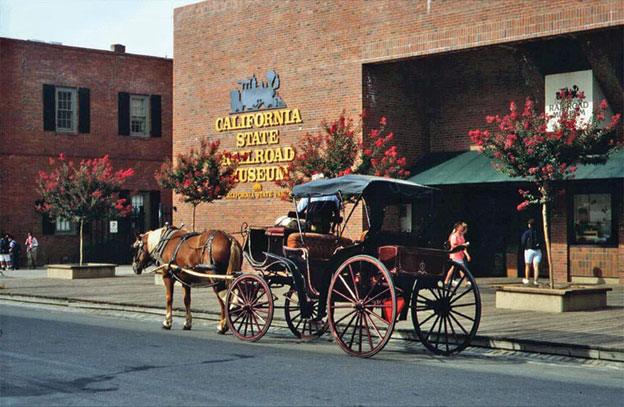(Above): A museum docent relates the history of the Gov. Stanford.
Emotionally I was ready, as an adult, to venture forth in the world and discover a treasure trove of pleasure aboard trains from California to Canada to Europe to North Africa. There were letdowns as the politicians in Congress took it upon themselves to kowtow to the airline lobbies and dismantle as much of the domestic passenger rail systems as possible. Ronald Reagan, well known for his anti-Amtrak stance, was instrumental in getting rid of the popular Starlight that ran from Los Angeles to Seattle over some of the most spectacular and beautiful landscape the three states could offer.
Following that, the California Zephyr riding through unparalleled natural vistas as the Feather River canyon was dismantled and today’s Zephyr is no more than a shadow of its former self. My wife and I traveled, in the 1960s to a ceremonial farewell to the original Zeyphr trip through the dramatic Feather River to Quincy where an overnight wake and memorial was held. Since then, another railroad has taken up the Zephyr that no longer rails through much of the Zephyr’s original run through the Feather River country.
And now we begin our trip of memories, a style and grace long gone and never to return. Our trip took to the California State Railroad Museum in Sacramento on the edge of the popular Old Town venue. To make our journey a “total” railroad adventure, we rambled up on the popular Amtrak Capitol Corridor from Emeryville to Sacramento. Despite the numerous times I have traveled these rails, it remains a journey of serenity and wonderful vistas. We travel along the “art gallery” of graffiti along the Berkeley industrial wall, the pastoral views of wetlands filled with life along the Carquinez Strait and through the confluence of massive pipes, storage bins of C&H Sugar in Crockett forming a palette of engineering art. The Amtrak passenger cars are clean and comfortable with many tables, Wi-Fi and lounge with beverages and snacks.
The museum is so vast and our space so limited, I can only highlight the most affective of the so many examples of what was once America’s world-class transportation hub. Enter this massive barn, and encounter the legendary, diminutive wood-burning steam locomotive, the Gov. Stanford. Built in 1862 in Philadelphia, it was shipped in parts around the horn by sailing vessel to Sacramento and reassembled at “K” and Front Streets, near the present museum and rail station sites. Until its retirement in 1895, the Stanford was the first excursion train, the first revenue freight train and first scheduled passenger train for Central Pacific Railroad. The engaging modest locomotive with is bulbous stack also played a major role in transporting materials for the construction of the Central Pacific over the Sierra Nevada.

(Above): The extensive model train diorama.
The next station, in this daunting achievement in American history, is to visit the dramatic life-size tableaux of laying the rails over the foreboding Sierra Nevada that literally makes the visitor part of the theater. The display is dominated by a huge locomotive surrounded by workers at their job, an example of the ubiquitous snow tunnels, that still today, keep the threatening snow above at bay. At the top of the this static, yet moving performance art, is a representative of the thousands of Chinese laborers that were immigrated from their homeland to handle the grunge works. Little effort was done to make their life as viable as it could be and prevent the ongoing accidents that caused thousands of injuries and death. A dramatic scenario of the never-ending battle combating the forces of winter.
Because of the deeply imbedded history of the railroad and the seemingly overwhelming acres of space in the museum, there is an army of knowledgeable and passionate docents everywhere. Most of them are retired veterans of the rail and cannot only give a distinctive answer to your most arcane questions, but engage you with their own adventures traveling across the thousands of miles of rail while watching over the varied needs of the montage and diversity of passengers.
On the second floor is, for this visitor, a new and absolutely seductively fun-filled exhibition and layout that strikes the child in every one, greeted me. Toy and model trains are everywhere; some simply mounted for your inspection, others running through beautifully sculptured hills and valley, villages populated with diminutive mannequins. The memory of Pop’s huge German toy locomotive I pedaled room to room and the tiny, snowbound Christmas diorama under the tree flooded my thoughts.
The joy of the family visitors as they tour the finest exhibition of model trains, I would think, in the West, if not in the nation, is palpable in the adult comments and the children scrambling from one diorama to another. Next to the model trains is what really captures the excitement of the hyperactive toddlers. A varied and colorful array of toy train tables and games are captured in the sound of laughter and glee of the children. Those wonderful wooden trains we all remember as toddlers are pushed, pulled and rolled on tracks while the “engineer” sound their “whoo-whoo” and “all aboard!” Just as giggly are the obviously joy-filled moms, flashing wide smiles and cameras.

(Above): Toddlers’ fun toy trains.
Leaving the new rail buffs of the future, we wander deeper into this cavernous train barn, surrounded by mammoth iron monsters depicting the beginning of a connected and mobile country. The sheer size brings to mind our true size and how humans created some of the most powerful machines that linked worlds around this vast orb. But, even with all this mind boggling technology and provenance there is a very robust people-element that make all this work.
Throughout the museum are docents with more knowledge than seems possible, mostly manned by some still-working railroad museum volunteers, amateur rail-buffs and retired railroad veterans.
They all role-play the foundation of railroads around the world: engineers, firemen, conductors, ticket agencies, and so many more. It’s difficult not to be immersed in the rhythm of the tons of rolling stock beginning its departure bringing new worlds to people or products to the people. Just a few words of interest or query and you know these happy campers are still doing what they love. Ask a question and, to be sure, you will be regaled by personal stories filled with the romance and history of rail lore. And there are captivating side tours that, too, encapsulate the saga of all the colossal iron dinosaurs around you.

(Above): Locomotive maintenance scene.
At the top of the storied trains in the West is the legendary Santa Fe Super Chief from Los Angeles to Chicago. Sophisticated sleeping accommodations for names like Gary Cooper, Clark Gable, Bette Davis, Carol Lombard, Orson Welles; the names go on without end. A dining car with white linen, fine china, sterling utensils, all prepared by master chefs and served by a staff of waiters seemingly doing ballet along the narrow aisle between tables. The meals, from breakfast to dinner rivaled gourmet San Francisco restaurants. If nothing else, the railroad setting was purely democratic, for every passenger could partake of these offerings.
A unique feature of this glamorous star of rail travel was the dome cars that offered passengers wide-screen views of the passing world. The cars of the Super Chief were all named to honor the Indian pueblos or tribes of the Southwest with the revolutionary lightweight dining car called Cochiti. A walk-through tour displays for the visitors the many table settings of the Cochita as well of other setting that were to be found on all the long-distance trains of the era. In another car, is a historical display of the many china settings used by U.S. Presidents as passengers on their way to speaking engagements, political ventures, vacations, etc.
After a long and entertaining day through the world of rail experiences there’s double pleasure waiting the visitor. Just a few steps away is Sacramento Old Town where all this began. Restored theme buildings housing restaurants, lounges, gift stores and much more. Sit on a veranda and sip your favorite beverage and smile as you relive the day. Meals from pizza to fine dining also awaits your pleasure to end the memories.

(Above): California State Railroad Museum facade.
This report of rambling through the entrancing halls, reminding us of the sweat and blood and imagination that gave us this railroad phenomenon, its romance, the beginning of a nation and, above all, memories that will linger forever has been a bit frustrating. There is so much packed into the California State Railroad Museum our allotted space simply isn’t sufficient to tell a full story. I can only close by inviting you to visit this impact-loaded and historical venue. Bring your children, so they will never forget an important epoch of what we are today.
This is one of the most full-throttle family entertainment and learning experiences that shouldn’t be missed. Dollar for dollar, the best entertaining education in town.
When You Go:
Address: 125 “I” St., Sacramento, CA 95814
Phone: (916) 323-9280
Website: www.csfm.org
Admission: $10 adults; $5 youths (6-17); children under 5 free.
The California State Railroad Museum offers its visitors guided tours and interpretive screenings daily, train rides, an extensive railroad library, plus a kaleidoscope of hands-on events and programs to engage visitors of all ages.